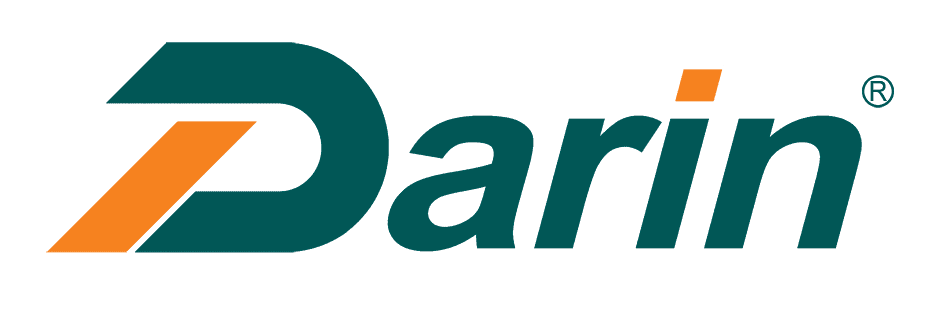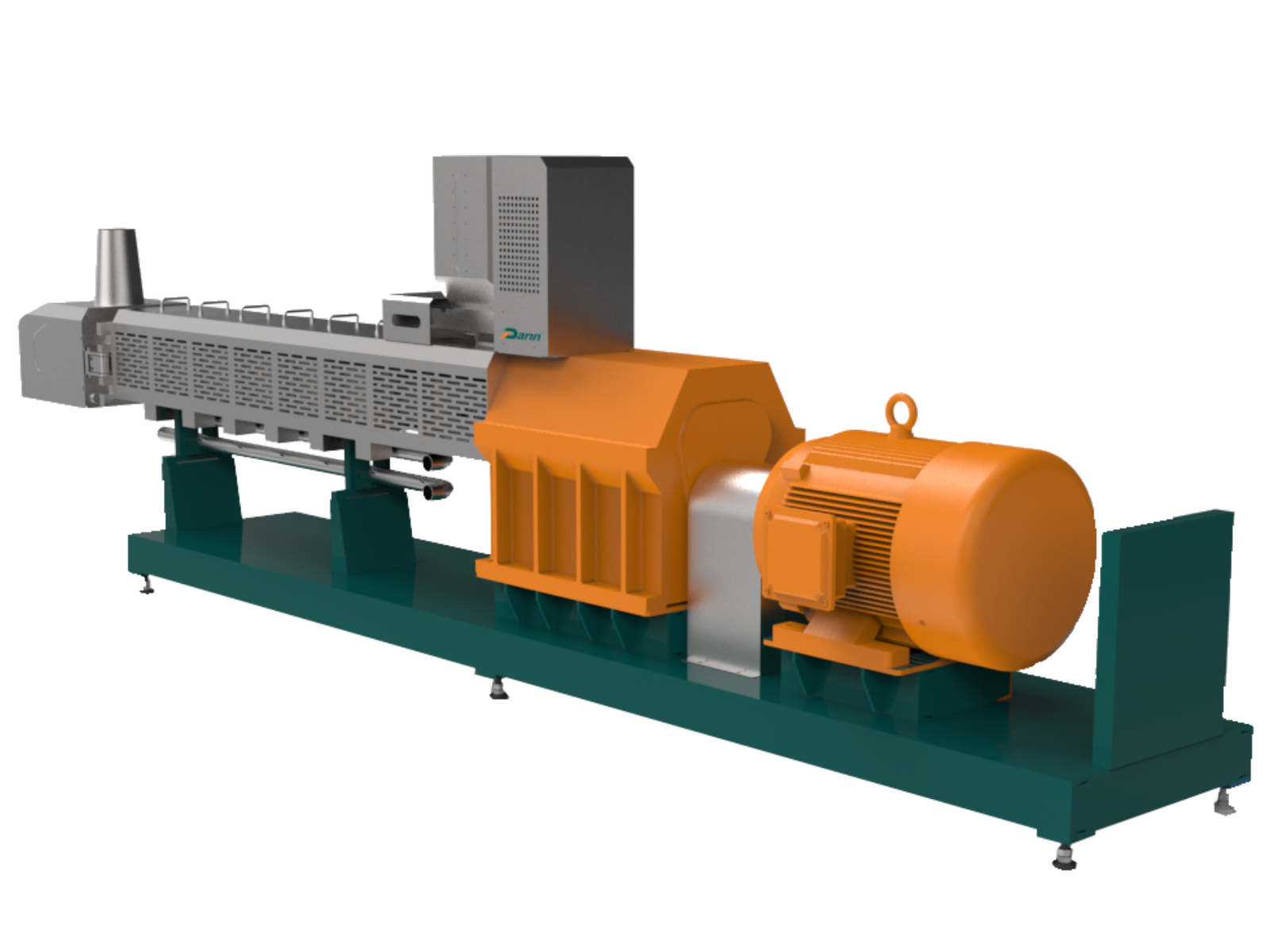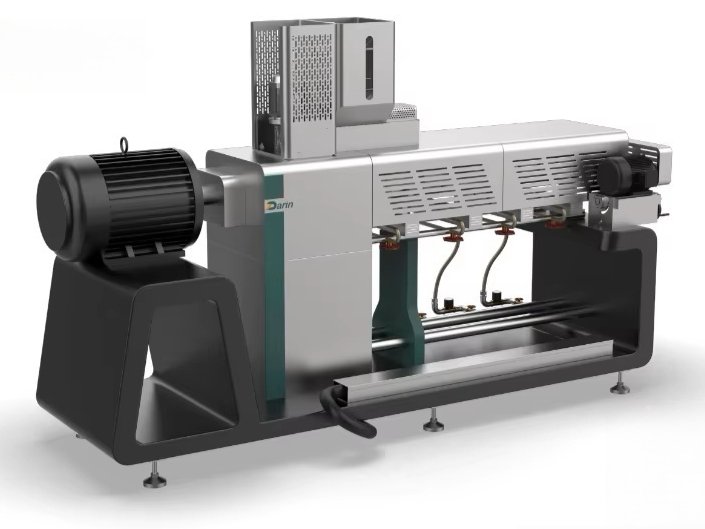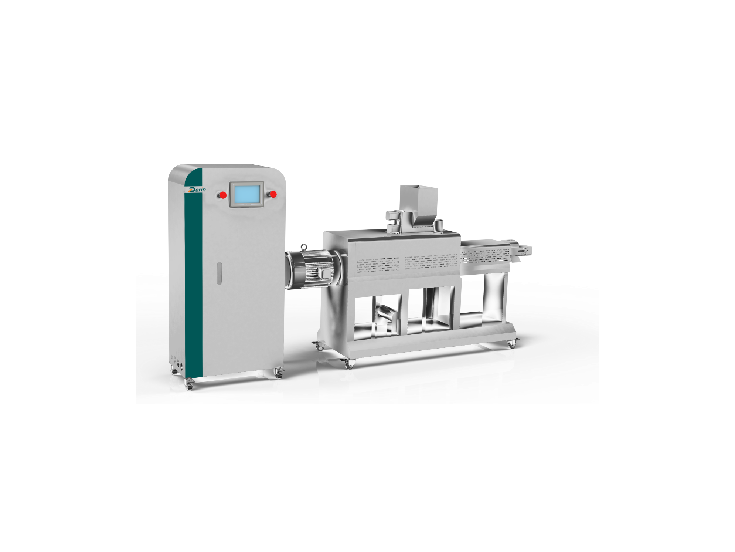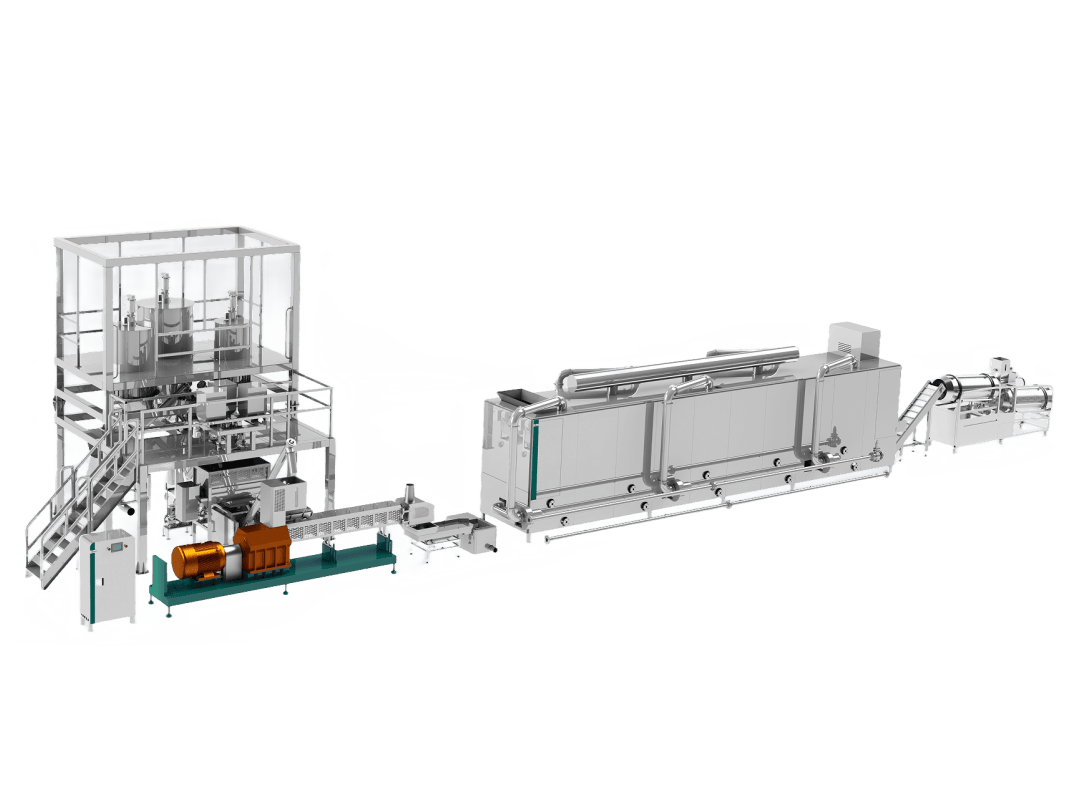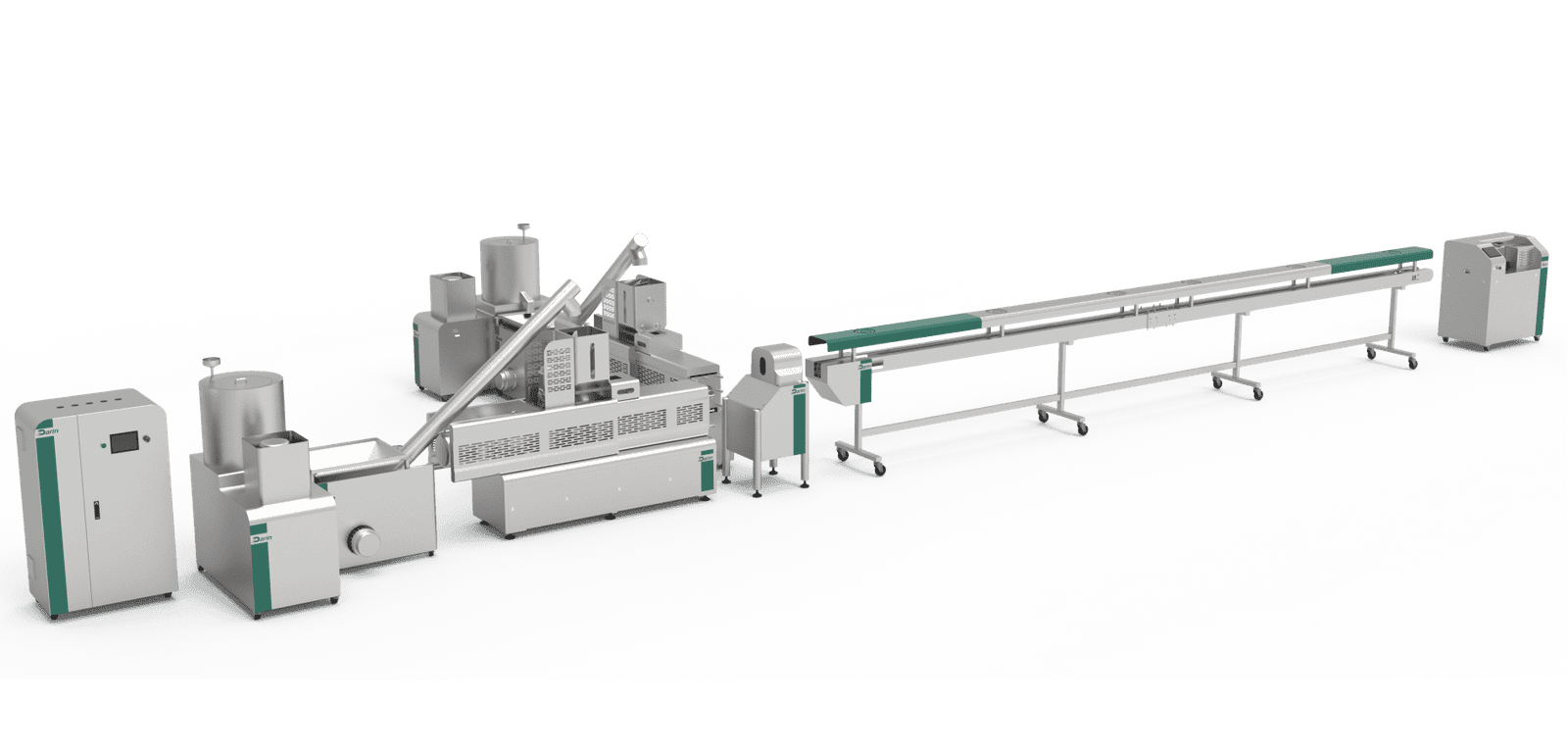
Ever wondered what makes a fish feed pellet machine tick?
Fish feed pellet machines come in various types, including dry and wet extruders, each designed to cater to different production needs and scales. Dry type extruders are suitable for small to medium operations, while wet type extruders are ideal for larger, more industrial-scale production due to their ability to produce higher quality pellets.
When I first ventured into aquaculture, the array of choices for pellet machines was overwhelming. But as I dug deeper, I realized that understanding the nuances between dry and wet extruders could make or break my operation's success. Each has unique features and capabilities that align with specific production goals. As you consider which machine fits your needs, think about the scale of your operations, the quality of feed you aim to produce, and how each machine's characteristics match your long-term vision. It's not just about buying a piece of equipment; it's about investing in a tool that will help you thrive in the world of aquaculture.
Wet extruders are ideal for small operations.False
Wet extruders are suited for large-scale production, not small ones.
Dry extruders produce lower quality pellets than wet extruders.True
Wet extruders can produce higher quality pellets due to moisture control.
How Do Dry Type Fish Feed Extruders Work?
Ever wondered how those little fish pellets are made? Let's dive into the fascinating world of dry type fish feed extruders and see how they work their magic!
Dry type fish feed extruders work by using mechanical pressure and heat to cook and shape feed ingredients. They mix, heat, and expand ingredients, producing uniform pellets that float or sink based on formulation.
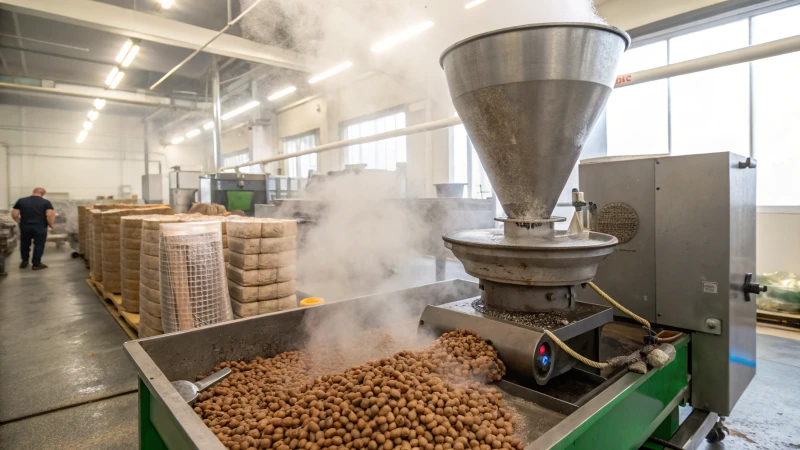
The Process Behind Dry Type Fish Feed Extruders
I still remember the first time I saw a dry type fish feed extruder in action. It was like watching an elaborate dance of gears and ingredients coming together in perfect harmony. These machines are marvels of engineering, using a blend of mechanical pressure1 and heat to transform raw materials into precisely shaped fish feed.
Key Steps in Operation
- Mixing: Imagine standing at the edge of a whirring barrel where all the magic begins. Ingredients, like grains and proteins, swirl together until they form a seamless mixture. It's like cooking a hearty stew—everything needs to blend just right to ensure that each bite (or pellet) is packed with nutrients.
- Heating: Then comes the heat, and not just any heat, but the kind that's carefully controlled through mechanical friction. It's fascinating to think about how this step cooks the ingredients just enough to preserve their nutritional value, much like the way you might simmer a sauce to perfection.
- Shaping: Finally, as if stepping through a portal, the cooked mix meets the die, shaping it into uniform pellets. It's akin to how cookie cutters stamp out perfect shapes—each pellet identical in form, ready to float or sink as needed.
| Step | Purpose | Outcome |
|---|---|---|
| Mixing | Blend ingredients uniformly | Nutrient consistency |
| Heating | Cook ingredients through friction | Safe, digestible feed |
| Shaping | Form pellets using a die | Uniform pellets ready for use |
Benefits of Using Dry Type Extruders
What I love about these extruders is their energy efficiency. They remind me of those clever kitchen gadgets that do a lot with very little effort, making them cost-effective and environmentally friendly. They're versatile too, able to produce both floating and sinking feeds by adjusting formulation and processing parameters.
But perhaps the most impressive part is how they preserve nutrients. Just like when you're trying to keep all the goodness in your veggies by steaming them instead of boiling, these extruders ensure essential nutrients stay intact, supporting healthy fish growth.
For more insights into improving production efficiency with these machines, check out fish feed production insights2. You can also explore more about energy-efficient machinery3 to optimize your operations.
Challenges and Considerations
Of course, no machine is without its quirks:
- Ingredient Variability: Different raw materials can affect the extrusion process; it's like trying to bake bread with different types of flour—you have to adjust moisture content and temperature just right.
- Maintenance Needs: Keeping these machines in top shape is essential for consistent performance.
- Initial Investment: Although cost-effective in the long run, purchasing high-quality equipment can be significant initially—much like buying a high-quality oven; it pays off in reliability and longevity.
By learning more about managing ingredient variability4 and maintenance strategies5, you can tackle these challenges head-on.
Understanding these aspects can truly revolutionize your aquaculture operations by enhancing both production efficiency and product quality.
Dry type extruders use only heat for fish feed production.False
They use both mechanical pressure and heat, not just heat.
Pellet shape is determined by the extruder die design.True
The die design in the extruder shapes the final pellet form.
Why Should You Consider Wet Type Fish Feed Extruders?
Imagine revolutionizing your fish farming with a machine that promises better feed quality and efficiency. Intrigued? Let me share how wet type fish feed extruders could be the game-changer for your aquaculture business.
Wet type fish feed extruders offer superior nutrient retention, better feed conversion rates, and higher production flexibility compared to dry type extruders. These benefits make them ideal for high-quality aquaculture feed production.
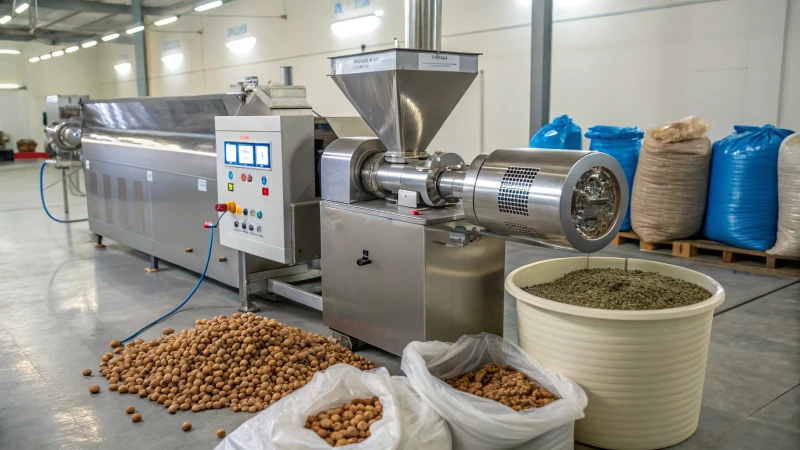
Nutrient Retention and Feed Quality
I've always been fascinated by how technology can enhance our everyday processes, and when it comes to aquaculture, it's no different. Wet type fish feed extruders leverage steam to cook feed ingredients, preserving essential nutrients in the process. This method ensures that the feed is not only more nutritious but also more appealing to the fish. I remember hearing from a fellow farmer who switched to this method and noticed a significant improvement in his fish's growth rates and overall health.
Moreover, the moisture content retained during this process results in a softer pellet that's easier for fish to digest. Nutrient retention6 isn't just a technical term; it's a lifeline for fish farmers aiming for success, as it directly impacts fish health and growth.
Improved Feed Conversion Ratios
One of my favorite aspects of wet type extruders is their ability to improve feed conversion ratios (FCRs). These machines optimize the cooking process, which enhances feed digestibility. Less waste means more efficient use of resources. I recall a time when I was struggling with high feeding costs and waste; switching to a wet type extruder drastically reduced these issues.
In aquaculture, achieving a low FCR means less feed is needed to produce the same amount of fish biomass. This not only cuts feeding costs but also minimizes environmental impact due to lower waste output.
| Parameter | Wet Type Extruder | Dry Type Extruder |
|---|---|---|
| Nutrient Retention | High | Moderate |
| Feed Conversion | Improved | Standard |
| Moisture Content | Higher | Lower |
Production Flexibility
Flexibility in production is another fantastic feature of wet type extruders. They can handle a diverse range of ingredients, allowing producers like me to create unique feed formulations tailored to specific fish species or life stages. I’ve found that the ability to adjust moisture levels and cooking times gives manufacturers the chance to produce both floating and sinking pellets, catering to various market demands. This adaptability has been crucial for me when trying to expand into new markets or diversify product offerings. Production flexibility7 ensures that manufacturers can meet consumer needs effectively.
Economic Considerations
I won't lie—wet type extruders might come with a higher initial price tag compared to their dry counterparts. However, their long-term benefits can lead to significant savings. With improved efficiency, better feed quality, and reduced wastage, operational costs decrease over time.
I see investing in a wet type extruder as a strategic move, one that pays off through enhanced production capabilities and stronger market positioning. Economic considerations8 are key for any business aiming for sustainable growth in the competitive aquaculture industry.
Wet extruders improve fish growth rates.True
Wet type extruders enhance nutrient retention, leading to healthier fish.
Dry extruders have better nutrient retention.False
Wet extruders retain more nutrients due to steam cooking.
Which Machine Is Best for Small Scale Operations?
Navigating the maze of machinery options for your small business can feel overwhelming, but it's crucial to find the right fit for efficiency and growth.
The best machine for small-scale operations balances efficiency, affordability, and adaptability. Consider machines that offer multi-functionality, scalability, and user-friendly features to accommodate growth without significant investment.

Understanding the Needs of Small Scale Operations
When I first started my small business journey, I vividly recall the anxiety that came with choosing the right equipment. It’s not just about buying a piece of machinery; it’s about investing in something that will evolve with your business. You need machines that are cost-effective yet versatile enough to handle multiple tasks without a hitch.
Evaluating Machine Types
Multi-Functional Machines
- I remember discovering a compact 3D printer that completely changed how I operated. It was like having a Swiss Army knife for production—able to craft various items with ease.
Scalable Machines
- One piece of advice I received early on was to think about growth. Modular machines, like certain packaging units9, allow you to start small and expand as needed—perfect for when you're ready to scale up.
User-Friendly Machines
- For those of us who aren’t naturally tech-savvy, finding equipment with intuitive controls is a game changer. I once struggled with a complex machine until switching to one with a touch-screen interface; it was as simple as using a smartphone.
| Machine Type | Features | Example |
|---|---|---|
| Multi-Functional | Versatile, multiple applications | Compact 3D Printer |
| Scalable | Upgradeable, expandable | Modular Packaging Machine |
| User-Friendly | Easy operation, minimal training | Touch-Screen Interface |
Industry-Specific Considerations
Reflecting on the pet food processing sector, it's clear that specialized machines like compact extruders or mini mixers can make all the difference. These devices not only fit snugly into smaller spaces but also allow for a wide range of product experimentation—something I found invaluable when trying to innovate without breaking the bank.
- Compact Extruders: Allowing for the production of varied pet snacks with simple ingredient swaps.
- Mini Mixers: Perfect for blending small batches of ingredients, ensuring uniformity in each product.
Analyzing Cost vs. Benefit
In my experience, weighing the initial costs against long-term benefits is crucial. A more expensive machine might seem daunting at first, but consider how it could save money in the long run through durability and efficiency. I always recommend checking out industry reviews10 and getting expert opinions to ensure you're making a well-informed choice.
Ultimately, your ideal machine should align with your production goals and growth ambitions. Whether you're crafting artisan snacks or scaling up a pet food line, the right equipment is out there waiting for you.
Multi-functional machines are cost-effective for small businesses.True
They perform various tasks, reducing the need for multiple machines.
User-friendly machines increase operational errors in small teams.False
Intuitive controls reduce errors by simplifying operation and training.
How Can We Ensure Quality in Fish Feed Production?
Ever wonder what goes into making top-quality fish feed? It's more than just tossing ingredients together—it's an art and a science combined!
Ensuring quality in fish feed production involves selecting premium ingredients, adhering to precise nutritional formulations, implementing rigorous testing, and maintaining strict hygiene standards in manufacturing processes. These steps help produce nutritious and safe feed that supports optimal fish health and growth.

Importance of Ingredient Selection
When I first started delving into fish feed production, I learned that the secret really does lie in the ingredients. Imagine crafting a dish where every bite contributes to health and vitality; that's what premium fish feed does. It was like being a chef, selecting only the finest fish meal11, soy protein, and corn gluten. Each component needs to be scrutinized not just for its nutrient profile but also for its freshness. It's amazing how something as simple as ingredient quality can impact the entire ecosystem.
Precise Nutritional Formulation
Creating the perfect balance of proteins, fats, vitamins, and minerals is like conducting a symphony for fish health. I remember attending a workshop where experts used advanced software to fine-tune formulations. It was eye-opening to see how precise calculations can cater to the specific needs of different fish species, ensuring they grow healthy and strong. It felt like we were providing them with a tailored diet plan, crafted with care and precision.
Rigorous Quality Testing
Quality testing was something I initially underestimated until I visited a facility where they ran lab tests for contaminants like mycotoxins and heavy metals. Seeing the dedication to safety and quality control reminded me of baking at home—constantly tasting and adjusting to ensure perfection. It's rigorous, yes, but knowing that every batch is tested for impurities made me appreciate the hard work that goes into every pellet of feed.
| Test Type | Frequency | Purpose |
|---|---|---|
| Nutrient Analysis | Monthly | Ensure proper nutrient levels |
| Microbial Tests | Weekly | Check for harmful bacteria |
| Chemical Testing | Quarterly | Detect contaminants |
Maintaining Hygiene Standards
Walking through a spotless manufacturing facility reminded me of the importance of cleanliness. Just like maintaining a clean kitchen prevents food poisoning, strict hygiene protocols in feed production prevent contamination. The automated cleaning functions of modern equipment were impressive, ensuring that every nook and cranny was sanitized. It's like having a robotic assistant who never misses a spot!
Training and Compliance
I can't emphasize enough how training is crucial. By educating staff on quality standards and compliance with regulations, we empower them to maintain excellence in production. Regular training sessions are like refreshers that keep everyone sharp and informed about local and international standards such as ISO. It's rewarding to see how a well-informed team contributes to the overall quality and safety of the fish feed we produce.
By focusing on these key areas, I've seen firsthand how we can produce high-quality, nutritious, and safe fish feed that not only supports sustainable aquaculture practices but also ensures that every fish meal12 is a step towards healthier aquatic life.
Fish meal is a premium ingredient in fish feed.True
Fish meal is widely recognized for its high protein content, essential for fish growth.
Chemical testing of fish feed should be done weekly.False
Chemical testing is typically done quarterly to detect contaminants efficiently.
What Factors Influence the Cost of Fish Feed Machines?
Ever wondered why fish feed machines can cost a small fortune? It's not just about the metal and bolts. Let's dive into the nitty-gritty details that drive those price tags.
Fish feed machine costs are influenced by technology, production capacity, energy efficiency, brand reputation, and geographic location. Custom features, certifications, and material quality also play key roles in pricing.

Technological Features
When I first stepped into the world of fish feed machinery, the sheer range of technological options13 was overwhelming. You might think that a machine is just a machine, but trust me, the level of tech inside can make or break your budget. Machines with advanced automation and smart sensors are like the Teslas of the fish feed world—they cost more but promise greater efficiency and quality control.
| Feature | Impact on Cost |
|---|---|
| Automation | High |
| Sensors | Medium to High |
| Basic Functionality | Low |
Production Capacity
I remember visiting a bustling fish farm where time was money. The owner showed me how their high-capacity machine churned out tons of feed every hour, a necessity for meeting their massive demands. These machines come with a heftier price tag, but when you're feeding thousands of fish, every penny counts toward ensuring you have enough capacity.
Energy Efficiency
Energy-efficient machines might seem like a splurge at first glance. However, I've learned from seasoned pros that what you spend initially can save you heaps in operational costs down the line. It's like buying an energy-efficient fridge—you pay more upfront but reap the rewards in lower electricity bills.
Brand Reputation and Support
In my early days of working with machinery, I quickly discovered that brand reputation holds weight. Some brands charge more because their machines are known to run without hiccups for years. Plus, having solid after-sales support can save a lot of headaches—something I value highly after dealing with less-than-helpful support teams in the past.
Geographic Location
Where a machine is made can really change its price point. I once ordered machinery from overseas and got hit with unexpected shipping costs. Sometimes, buying local or from regions with lower manufacturing costs can offer better deals without compromising quality.
Custom Features and Specifications
Sometimes you need something tailor-made to fit unique production needs. Customizations can get pricey due to the specialized engineering involved. I recall a time when we needed a particular feature added, and while it stretched our budget, it ultimately enhanced our production process significantly.
Certifications and Standards
I've learned the hard way that certifications aren't just fancy badges—they're a testament to quality and safety standards. Machines with CE or ISO certifications might be pricier, but they assure compliance with international standards—crucial if you're eyeing global markets.
Material Quality
Finally, let’s not overlook material quality. A machine made with high-grade materials might cost more initially but often pays off in durability and maintenance savings. Think of it like investing in a sturdy pair of shoes—they last longer and save you from frequent replacements.
As you weigh these factors, consider what aligns best with your business needs and long-term goals. It's all about finding that sweet spot between cost and functionality to make a smart investment.
Automation in fish feed machines increases cost significantly.True
Advanced automation systems enhance efficiency but raise machine costs.
Geographic location does not affect fish feed machine pricing.False
Manufacturing and shipping costs vary by location, affecting prices.
What Alternative Technologies Should Pet Food Manufacturers Consider?
Ever felt like your pet food production line could use a high-tech makeover?
Alternative technologies in the pet food industry include automation and robotics, sustainable packaging, and advanced nutritional formulations. These innovations enhance efficiency, reduce environmental impact, and meet evolving consumer demands.
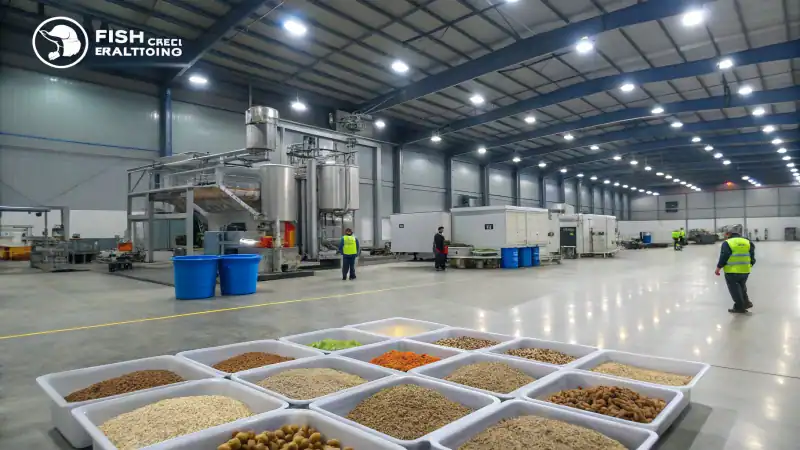
Automation and Robotics
I remember when I first introduced automated systems into my production lines. It felt like stepping into the future. Watching robots precisely mix ingredients and handle packaging solutions14 without missing a beat was astonishing. This shift not only reduced human error but ensured that every single product that rolled off the line was of consistent quality. It was like having a team of tireless perfectionists working round the clock.
Sustainable Packaging
There’s something deeply satisfying about contributing to a greener planet while running a business. Embracing sustainable packaging solutions was a game-changer for me. We started exploring biodegradable materials and recyclable options, and not only did it reduce waste, but it also resonated with environmentally conscious consumers. It felt great knowing we were enhancing our brand reputation while doing right by the earth.
Advanced Nutritional Formulations
Pets are family, and as their dietary needs become more specialized, I found myself diving deeper into nutritional science. We began leveraging new technologies to blend nutrients precisely, ensuring optimal health for our furry friends. Crafting products tailored to specific dietary needs wasn't just about marketability; it felt personal, almost like preparing a gourmet meal for a loved one.
Energy-Efficient Machinery
Energy efficiency became a priority when I realized how much it could cut costs without sacrificing performance. Investing in modern machinery designed to consume less energy was particularly crucial for our high-volume operations. Not only did this help lower operational costs, but it also aligned with our sustainability goals—proving that you can be eco-friendly and economically savvy at the same time.
| Technology | Benefits |
|---|---|
| Automation and Robotics | Increased precision and efficiency |
| Sustainable Packaging | Reduced environmental impact |
| Advanced Nutritional Formulations | Tailored products for pet health |
| Energy-Efficient Machinery | Lower operational costs and sustainability |
By embracing these technologies, I've watched the pet food industry evolve dramatically. Adopting such innovations doesn't just keep companies competitive; it steers us toward a more sustainable future. I'm excited about exploring future breakthroughs, like biotechnology applications15, which promise to further transform our industry.
Automation reduces human error in pet food production.True
Automated systems streamline processes, reducing human error and increasing output.
Sustainable packaging increases environmental waste in the pet food industry.False
Sustainable packaging reduces waste, appealing to eco-conscious consumers.
Conclusion
Explore the various types of fish feed pellet machines, including dry and wet extruders, their operational processes, benefits, challenges, and how to choose the right equipment for aquaculture.
Discover how mechanical pressure contributes to effective fish feed extrusion. ↩
Learn how efficient fish feed production enhances aquaculture operations. ↩
Explore machines that optimize energy use in fish feed production. ↩
Find strategies to handle ingredient changes during extrusion. ↩
Learn maintenance tips to prolong extruder lifespan. ↩
Understand how nutrient retention influences fish health and growth, making wet extruders a smart choice for high-quality feed production. ↩
Explore how adaptable production processes allow for diverse and tailored fish feed formulations, increasing market opportunities. ↩
Learn how investing in these extruders can reduce long-term costs through improved efficiency and higher quality feed output. ↩
Explore the flexibility and growth potential of modular machines, suitable for evolving business needs. ↩
Industry reviews provide insights into machine performance and reliability, helping you make informed decisions. ↩
Discover which ingredients are considered premium for enhancing fish nutrition. ↩
Learn the key elements of creating effective fish feed formulations. ↩
Explore how advanced technology enhances machine efficiency and performance, providing potential cost benefits. ↩
Discover how innovative packaging solutions can reduce waste and appeal to eco-conscious consumers. ↩
Explore how biotechnology could revolutionize pet food production and formulation. ↩
